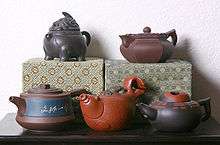Yixing clay teapot

Yixing clay teapots (simplified Chinese: 宜兴; traditional Chinese: 宜興; pinyin: Yíxīng; Wade–Giles: I-Hsing) (also called Purple Sand (Chinese: 紫砂; pinyin: zǐshā; Wade–Giles: tsu sha) are made from Yixing clay. This traditional style commonly used to brew tea originated in China, dating back to the 15th century, and are made from clay produced near Yixing in the eastern Chinese province of Jiangsu.
History
Archaeological excavations reveal that as early as the Song dynasty (10th century) potters near Yixing were using local "zisha" (紫砂 or 紫泥 ; literally, "purple sand/clay") to make utensils that may have functioned as teapots. According to the Ming dynasty author Zhou Gaoqi, during the reign of the Zhengde Emperor, a monk from Jinsha Temple (Golden Sand Temple) in Yixing handcrafted a fine quality teapot from local clay. Such teapots soon became popular with the scholarly class, and the fame of Yixing teapots began to spread.
20th century
Yíxīng teapots are actually made in nearby Dīngshān, also known as Dingshu,[1] on the west side of Lake Tai.[2] Hundreds of teapot shops line the edges of the town's crowded streets and it is a popular tourist destination for many Chinese. While Dīngshān is home to dozens of ceramics factories, Yíxīng Zǐshā Factory Number 1, which opened in 1958, processes a large part of the clay used in the region, produces fine pottery ware, and has a large commercial showroom. In addition to the better known teapots, tea pets, oil and grain jars, flower vases, figurines, glazed tiles, tables, ornamental rocks, and even ornamental waste bins are all manufactured in the community.
Use with tea

Yixing teapots are meant for use with black and oolong teas, as well as aged pǔ’ěr tea. They can also be used for green or white tea, but the water must be allowed to cool to around 85 °C (185 °F) before pouring the water into the pot. Yixing teapots absorb a tiny amount of tea into the pot during brewing. After prolonged use, the pot will develop a coating that retains the flavour and colour of the tea. It is for this reason that soap should not be used to clean Yixing teapots. Instead, it should be rinsed with fresh water and allowed to air-dry. A studious tea connoisseur will only steep one type of tea in a particular pot, so as not to corrupt the flavour that has been absorbed.
Yixing teapots are smaller than their western counterparts as the tea is often brewed for only a few seconds before it is served to guests. Reusing the same tea leaves multiple times, the first brew of the tea leaf is usually used only to clean tea, teapot, and cups and is not to be consumed. Chinese people traditionally drink from cups that hold less than 30 ml of liquid and are simply repeatedly filled so that they may cool rapidly but can be ingested before the tea becomes cold.
Price
Prices can vary from a couple dozen to thousands of yuan.[3] A pot was auctioned in 2010 for 12.32 million yuan.[4] Some Chinese National treasures have even been deemed priceless. Generally, the price of Yixing teapots are dependent on such factors such as age, clay, artist, style and production methods. The more expensive pots are shaped by hand using wooden and bamboo tools to manipulate the clay into form, while cheaper Yixing pots are produced by slipcasting.
References
- ↑ Introducing Dīngshān from Lonely Planet. Retrieved 2013-01-11.
- ↑ Introducing Lake Tai from Lonely Planet. Retrieved 2013-01-11.
- ↑ "Antique Yixing Teapots". MingWrecks.com. 2011-09-17. Retrieved 2012-08-02.
- ↑ 北京紫砂壶拍卖创出1232万世界纪录(图)_新闻中心_新浪网 (in Chinese). Sina Corp. 2010-06-09. Retrieved 2012-08-02.
Further reading
| Wikimedia Commons has media related to Zisha. |
- K.S. Lo, et al., The Stonewares of Yixing: from the Ming period to the Present Day, (London: 1986, ISBN 0856671819).
- Wain, Peter, "A Taste of Transition: The Teapots of Yixing", Ceramic Review, 153, May/June 1995, pp. 42–45p
- Pan Chunfang, Yixing Pottery: the World of Chinese Tea Culture, (San Francisco, Long River Press: 2004, ISBN 159265018X).
External links
- Yixing Clay Teapot at China Online Museum
- "A Handbook of Chinese Ceramics". The Metropolitan Museum of Art Libraries. OCLC.
- "Zisha Teapots with National Living Treasure Zhou Gui Zhen and Zhu Jian Long". video of hand making a teapot